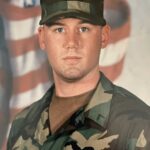2021 Honoree
U.S. Army
Iraq / Afghanistan
While attending grade school in Rose Park, Utah, Sergeant Gregory Orton decided that he was going to be a Soldier, and in 2004, right after high school graduation, he enlisted in the Army reserves and became a Combat Engineer.
Orton was about to request a transfer to active duty when his unit received word that they were deploying. Thinking, “I didn’t want to jump ship on my unit,” he put off his request until after the deployment. The 321st Engineer Battalion deployed to Ramadi in 2006, where Orton served as a team lead, improvised explosive device (IED) spotter, gunner, and RG-31 mine-resistant vehicle driver. His team conducted dangerous route-clearing operations and found IEDs almost daily, often two or three at a time. When he returned from the deployment, the Army was not entertaining transfers to active duty.
In 2010, Orton deployed to the Kunar Province, Afghanistan, where he led route-clearing missions as a squad leader in the 744th Engineer Company, 54th Engineer Battalion. One of the company’s missions was a sweep of the route between Jalalabad and Forward Operating Base Bostick to permit monthly supply runs. In March 2011, Orton’s team joined two others in sweeping the route for IED command wires. As the dismounted teams returned to their vehicles, the Taliban ambushed them from three sides, critically wounding another team lead. Orton crossed 40 meters under heavy fire to the wounded Soldier, shielded him with his own body, applied a tourniquet, and carried the Soldier to safety. When another team lead was wounded, Orton moved 130 meters up the mountain with the platoon sergeant to retrieve the wounded Soldier. Standing in the line of fire, Orton engaged the enemy as the litter team evacuated the wounded team leader. For his heroism, Orton received a Bronze Star with “V” device for valor. He also received another Bronze Star in recognition of his leadership.
In April 2011, Orton’s team was ambushed while dismounted from their vehicles. Directing his team to defensive positions as they began to engage the enemy, a round, as Orton puts it, “grazed” the left side of his head. Treatment for the Purple Heart recipient’s so-called grazing included a medically induced coma, several surgeries, and years of physical and speech therapy.
Although SGT Orton wishes that he had tilted his head a little to the right during that firefight, in reflecting on his service, he says, “I don’t regret any of it, but I do wish that I had made that jump to active duty. But even in the reserves, I would go back if I could.”

